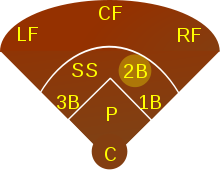Second baseman
"Second base" redirects here. For other uses, see Second base (disambiguation). The position of the second baseman Second base, or 2B, is the second of four stations on a baseball diamond which must be touched in succession by a base runner in order to score a run for that player's team.[1] A second baseman is the baseball player guarding second base.[1] Also called second bagger,[1] the second baseman often possesses quick hands and feet, needs the ability to get rid of the ball quickly, and must be able to make the pivot on a double play. In addition, second basemen are usually right-handed; only five left-handed throwing players have ever played second base since 1957.[2] Second base is also known as the keystone sack.[1] In the numbering system used to record defensive plays, the second baseman is assigned the number 4. Good second basemen need to have very good range, since they have to field balls closer to the first baseman who is often holding runners on, or moving towards the base to cover. On a batted ball to right field, the second baseman goes out towards the ball for the relay. Due to these requirements, second base is sometimes a primarily defensive position in the modern game, but there are hitting stars as well. Position description Outfielders must cover large distances, so speed, instincts and quickness to react to the ball are key. They must be able to catch fly balls above their head and on the run, as well as prevent balls hit down the right field foul line from g

tting past them. Being situated 250–300 feet from home plate, they must be able to throw the ball accurately over a long distance to be effective. Of all outfield positions, the right fielder often has the strongest arm, because they are the farthest from third base. The right fielder tends to be a stronger offensive player than defensive, as right-handed batters, which are more common than left-handed ones, tend to pull the ball to left field. As well as the requirements above, the right fielder backs up first base on all throws from the catcher and pitcher, when possible, and all bunted balls, since the catcher or the first baseman must be available for fielding the ball. The right fielder backs up second base on any ball thrown from the left side of the field, i.e. shortstop, third base, or foul line territory. The right fielder backs up first base when the first baseman is in a run down between 3rd base and home. Right field has developed a reputation in Little League as being a position where less talented players can be "hidden" without damaging a team's defense in any significant way.[citation needed] Unlike the major league level, where hitters have the ability to drive the ball into the outfield in all directions, most little league batters are unable to hit the ball out of the infield with any regularity. Additionally, since most batters are right-handed, the left fielder (and to some extent the center fielder) will have far more opportunities to make a play than the right fielder.